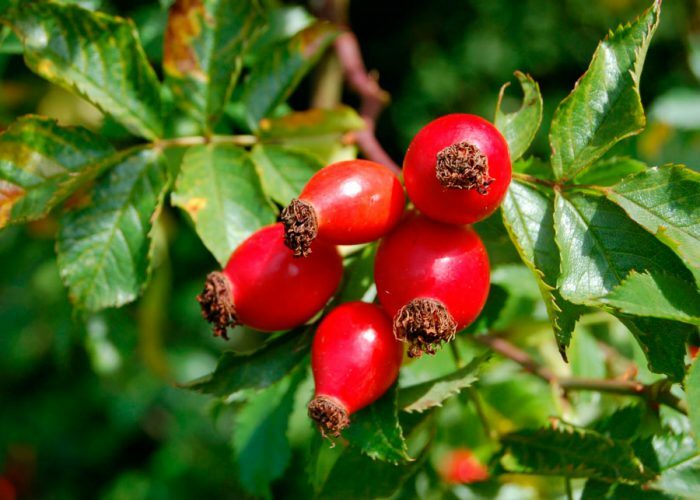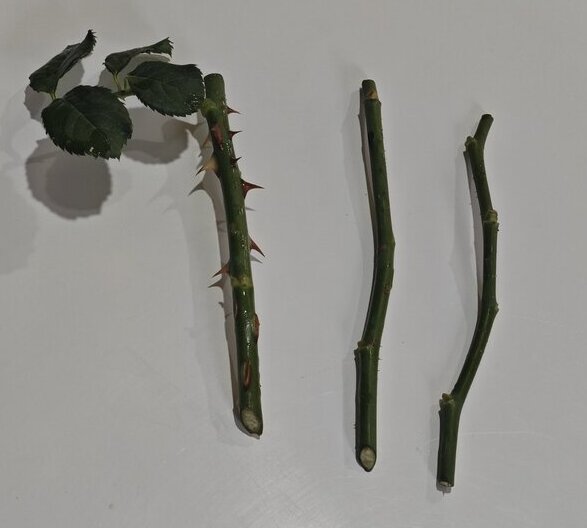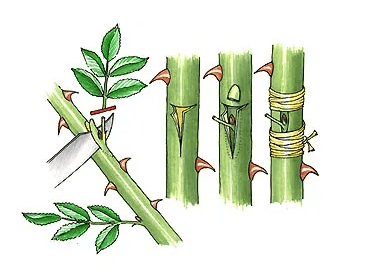Would you like to grow your rose? Today, I want to offer you a proven way to grow a beautiful rose for your garden. Winter grafting is highly effective for propagating roses year-round, particularly in controlled environments like greenhouses.
Selecting the Right Rootstock
For the best results, choose rose hip seedlings with a root neck diameter of at least 7.5 mm. After fall pruning, dig up the rootstocks and remove the above-ground growth, leaving 5-8 cm from the root neck. Store these rootstocks in a cool area, buried in moist sand or sawdust, to preserve their viability through winter.

Getting Ready for Grafting
In December, transplant the stored rootstocks into pots or bags around 18-20 cm in height and 11-13 cm in diameter. Fill them with nutrient-rich soil, incorporating organic fertilizers such as:
- Composted manure (a natural nitrogen source)
- Bone meal (rich in phosphorus to support root and flower development)
- Kelp or seaweed meal (providing trace minerals and natural growth hormones)
These organic materials will nourish the plants more sustainably compared to synthetic fertilizers.
Preparing Cuttings
During your autumn rose pruning, select cuttings for grafting. Follow these steps:
- Remove the thorns to make handling easier and avoid damaging the cuttings.
- Bundle by variety to stay organized and prevent mix-ups.
- Label each bundle to ensure every rose variety is identified correctly.
Wrap the cuttings in a damp cloth to maintain moisture, and store them in a cool, dark place until grafting begins.

The Grafting Process
Winter grafting is typically done in January or February. About a week before grafting, bring the rootstocks into the greenhouse, keeping the temperature around 18-20°C, and water them regularly. Start grafting once the rootstock’s bark becomes loose enough for easy cutting.
Preparing the Scion
Select scions with 2-3 healthy buds. Make a straight cut about 0.5 cm above a bud and an angled cut below the bottom bud.
Grafting the Scion to the Rootstock
- Make a 10-15 mm vertical cut in the rootstock.
- Insert the scion behind the loosened bark, aligning the cut edges.
- Secure the graft tightly to ensure the scion and rootstock bond properly.

Post-Grafting Rose Care
After grafting, water the plants thoroughly. Lay them sideways on racks covered with moist peat to keep the humidity high.
- Temperature: Maintain 18-20°C
- Humidity: Keep levels between 75-80%
The buds will begin sprouting in about 8-10 days. Once this happens, position the pots upright, reduce misting, and start ventilating the greenhouse.

Get Your Free Lunar Gardener's Calendar 2025!
Join the Lunar Gardening Revolution! Subscribe now to receive our exclusive Free Lunar Gardener’s Calendar for 2025. Harness the power of the moon to optimize your planting, nurturing, and harvesting.
Final Stages
Move the plants to a bright area with slightly cooler temperatures (10-13°C) two to three weeks after grafting. By spring, your grafted roses should be fully rooted and ready to be planted outdoors in their permanent spots.
This winter grafting method, combined with organic fertilizers and careful cuttings preparation, allows you to propagate healthy roses year-round, even in protected environments.

Blue for you rose
Frequently Asked Questions
Yes, winter propagation is possible through grafting in greenhouses, where temperature and humidity are controlled. Rootstocks are prepared in the fall and brought indoors to continue propagation during the colder months.
Yes, but the new plants will have the characteristics of the scion, not the rootstock. Some rose varieties may be more challenging to propagate from cuttings than others
To root rose cuttings fast:
- Use rooting hormone powder to encourage root development.
- Plant in well-draining soil, ideally a sand-compost mix.
- Maintain a warm, humid environment, like a mini greenhouse or plastic cover.
- Ensure the cutting gets indirect sunlight and that the soil remains consistently moist.

The Organic Rose Revolution: Grow Stunning Blooms, Naturally
- Unlock the secrets of nurturing your roses organically with our guidance on soil health, natural fertilizers, and sustainable pest control methods. Your garden will thrive with eco-friendly care that respects nature’s balance.
- Empower yourself with the knowledge to craft natural remedies for common rose ailments.
- Banish pests from your garden precisely using proven strategies that safeguard your roses without harsh chemicals. Keep aphids, mites, and other invaders at bay while preserving your garden’s natural harmony.
- Explore a world of breathtaking rose varieties carefully curated to captivate your senses and elevate your garden to new heights of beauty.

